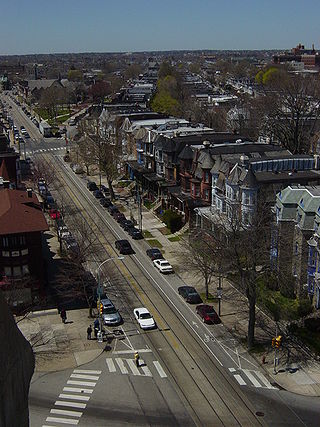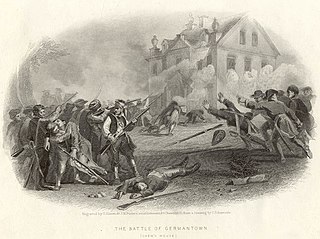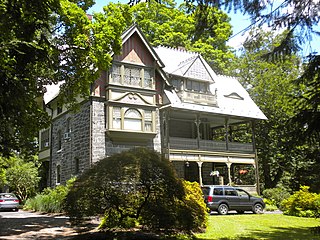
Germantown is an area in Northwest Philadelphia, Pennsylvania. Founded by Palatine, Quaker, and Mennonite families in 1683 as an independent borough, it was absorbed into Philadelphia in 1854. The area, which is about six miles northwest from the city center, now consists of two neighborhoods: 'Germantown' and 'East Germantown'.

West Philadelphia, nicknamed West Philly, is a section of the city of Philadelphia. Although there are no officially defined boundaries, it is generally considered to reach from the western shore of the Schuylkill River, to City Avenue to the northwest, Cobbs Creek to the southwest, and the SEPTA Media/Wawa Line to the south. An alternate definition includes all city land west of the Schuylkill; this would also include Southwest Philadelphia and its neighborhoods. The eastern side of West Philadelphia is also known as University City.

Awbury Arboretum is a nonprofit arboretum and estate located at 1 Awbury Road in Germantown, Philadelphia, Pennsylvania. Its grounds are open daily without charge. Established in 1916, it then became a nonprofit organization in 1984.

The Colonial Germantown Historic District is a designated National Historic Landmark District in the Germantown and Mount Airy neighborhoods of Philadelphia, Pennsylvania along both sides of Germantown Avenue. This road followed a Native American path from the Delaware River just north of Old City Philadelphia, through Germantown, about 6 miles northwest of Center City Philadelphia, and on to Pottstown. Settlement in the Germantown area began, at the invitation of William Penn, in 1683 by Nederlanders and Germans under the leadership of Francis Daniel Pastorius fleeing religious persecution.

The Whitney Avenue Historic District is a historic district in the East Rock neighborhood of New Haven, Connecticut. It is a 203-acre (82 ha) district which included 1,084 contributing buildings when it was listed on the National Register of Historic Places in 1989.

The Mill Street–North Clover Street Historic District is located along those streets and Main Street in western Poughkeepsie, New York, United States. It is an irregularly-shaped area of 27 acres (11 ha) between US 9 and downtown Poughkeepsie, located on the slope up from the Hudson River. There are roughly 139 historic buildings, and very few new ones.

The Chestnut Hill Historic District is a historic area covering all the Chestnut Hill section of Philadelphia, Pennsylvania.

The East Side Historic District is a primarily residential neighborhood located to the east of downtown Saratoga Springs, New York, United States. It is an irregularly shaped area 114 acres (46 ha) in size, extending almost to Saratoga Race Course from the neighborhood of Congress Park.

The Water Street District, a large part of downtown Lock Haven in the U.S. state of Pennsylvania, is a historic district added to the National Register of Historic Places (NRHP) in 1973. The district includes the city's entire central business district as well as many homes and churches constructed in the 19th century, especially during the Victorian era. An inventory of the district in 1973 listed more than 365 historic resources, many of which were associated with wealth created by the lumber industry.

Hamnett Historic District is a historic district in Wilkinsburg, Pennsylvania. Bordered roughly by Rebecca Avenue, the rear property lines on the east side of Center Street, Sewer Way, and Lytle Way, it encompasses 77 buildings and 114 acres.

The William Shelly School and Annex, also known as the Eberton School, is a historic school building and annex located in West York, York County, Pennsylvania. Built circa 1897, the Shelly Annex was initially designed as a one-room school, but was then enlarged twice between 1898 and 1903 to become a 2 1/2-story, gable roofed brick building which is three bays wide and seven bays deep. Built between 1905 and 1908, the Shelly School was designed in the Italian Renaissance style, and is a two-story brick structure which is nine bays wide and seven bays deep. Completely rebuilt following a fire in 1919, the property was sold in 1960; the buildings were then utilized as storage facilities for the next 37 years.

The Protection of the Flag Monument is a historic war memorial located in Academy Park at 715 South Main Street in Athens, Bradford County, Pennsylvania. Designed in the Classical Revival style by the architectural firm McKim, Mead & White, with a sculpture by George Thomas Brewster, it was erected between 1900 and 1902, and has a granite pedestal topped by a bronze sculpture group. The sculpture depicts an adult soldier and a young drummer boy attired in Revolutionary War clothing and protecting their flag from falling into enemy hands. A commemorative plaque indicates it was dedicated in memory of the soldiers who fought in defense of the flag.

The Chester Heights Camp Meeting Historic District is a historic Methodist camp meeting and national historic district located in Chester Heights, Delaware County, Pennsylvania. The district includes 101 contributing buildings, which were designed in the vernacular camp meeting style of architecture; additional notable examples of the Gothic Revival and Queen Anne styles also are present here. Public buildings include the contributing Tabernacle (1878), Dining Hall (1900), Youth Tabernacle (1909, and dormitory. Most of the contributing buildings are cottages, which were built roughly between 1876 and 1920.

Horace Jayne House (1895) is an architecturally significant building designed by architect Frank Furness in Philadelphia, Pennsylvania, United States. It is located at the southwest corner of 19th and Delancey Streets, about a block south of Rittenhouse Square.

The Philadelphia, Wilmington and Baltimore Railroad Freight Shed is an historic freight station in the Southwest Center City neighborhood of Philadelphia, Pennsylvania, along Broad Street. It was added to the National Register of Historic Places in 2011 and is today part of the Lincoln Square mixed-use development.

The John Nicholas and Elizabeth Moyer House, also known as Richland, is a historic home located in Jefferson Township in Berks County, Pennsylvania. Built circa 1817, it is a 2+1⁄2-story, four-over-four stone dwelling. A stone summer kitchen, which was built between 1818 and 1820, is attached to the rear. Frame additions were added in 1998.

Edmund Beaman Gilchrist was an American architect, best remembered for his English-Cotswold and French-Norman suburban houses.

Girard Avenue is a major commercial and residential street in Philadelphia, Pennsylvania. For most of its length it runs east–west, but at Frankford Avenue it makes a 135-degree turn north. Parts of the road are signed as U.S. Route 13 and U.S. Route 30.

The Christian Street Historic District is an historic district located along Christian Street in Philadelphia, Pennsylvania, United States. It is also known as Black Doctors' Row. The narrow district extends approximately six city blocks, from the 1400 block of Christian Street to the intersection of Christian Street with 20th Street. Its width is one block on either side of Christian Street, extending to Montrose Street and Webster Street. It is within the area known as South Philadelphia and the neighborhood known as Graduate Hospital.

The Francis Cope House is a historic building located on the grounds of the Awbury Arboretum in the U.S. city of Philadelphia, Pennsylvania. Nowadays it is a rentable space, owned by Awbury Arboretum.

























